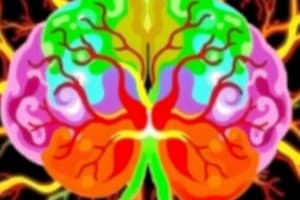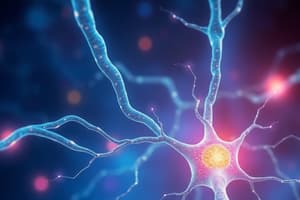Podcast
Questions and Answers
What occurs during the depolarization phase of a neuron?
What occurs during the depolarization phase of a neuron?
- The neuron's voltage remains unchanged.
- Positive ions rush into the cell. (correct)
- Negative ions leave the cell.
- The neuron starts its refractory period.
What is the role of neurotransmitters in neuron communication?
What is the role of neurotransmitters in neuron communication?
- They block receptor sites in the receiving neuron.
- They absorb excess ions from the synapse.
- They travel between neurons to facilitate signaling. (correct)
- They create action potentials in the sending neuron.
What is the main difference between agonists and antagonists?
What is the main difference between agonists and antagonists?
- Agonists mimic neurotransmitters, while antagonists inhibit their action. (correct)
- Agonists block neurotransmitter action, while antagonists enhance it.
- Agonists slow down neuron firing, while antagonists speed it up.
- Agonists work only in synaptic gaps, while antagonists act within the neuron.
What is the primary reason a neuron cannot fire again during the refractory period?
What is the primary reason a neuron cannot fire again during the refractory period?
How does reuptake affect neurotransmitter levels in the synapse?
How does reuptake affect neurotransmitter levels in the synapse?
What is the primary function of the occipital lobe?
What is the primary function of the occipital lobe?
Broca's Aphasia is characterized by:
Broca's Aphasia is characterized by:
Which part of the neuron is primarily responsible for conducting electrical impulses away from the cell body?
Which part of the neuron is primarily responsible for conducting electrical impulses away from the cell body?
How does the brain exhibit cortical plasticity?
How does the brain exhibit cortical plasticity?
What do sensory neurons primarily do?
What do sensory neurons primarily do?
Which structure helps speed up the transmission of electrical signals in neurons?
Which structure helps speed up the transmission of electrical signals in neurons?
What is the correct sequence of events during action potential?
What is the correct sequence of events during action potential?
What role do glial cells play in the nervous system?
What role do glial cells play in the nervous system?
What is the primary mechanism through which neurons communicate with each other?
What is the primary mechanism through which neurons communicate with each other?
What does the Sparse Coding hypothesis suggest about the activation of neurons?
What does the Sparse Coding hypothesis suggest about the activation of neurons?
What measurement technique is based on the hemodynamic response of the brain?
What measurement technique is based on the hemodynamic response of the brain?
Which hypothesis states that a single neuron may code for a very specific object?
Which hypothesis states that a single neuron may code for a very specific object?
What is the main purpose of Transcranial Magnetic Stimulation (TMS)?
What is the main purpose of Transcranial Magnetic Stimulation (TMS)?
How do event-related potentials (ERPs) work in EEG measurements?
How do event-related potentials (ERPs) work in EEG measurements?
What does the Blood-oxygen-level dependent (BOLD) response measure in fMRI?
What does the Blood-oxygen-level dependent (BOLD) response measure in fMRI?
What is the function of neural circuits?
What is the function of neural circuits?
What is the primary function of the Central Nervous System (CNS)?
What is the primary function of the Central Nervous System (CNS)?
Which of the following describes the function of the left hemisphere of the brain?
Which of the following describes the function of the left hemisphere of the brain?
What is the significance of the corpus callosum?
What is the significance of the corpus callosum?
What does the term 'contralateral processing' refer to?
What does the term 'contralateral processing' refer to?
What is the function of gray matter in the cerebral cortex?
What is the function of gray matter in the cerebral cortex?
What is the role of neuropsychology?
What is the role of neuropsychology?
Which structure is known for being the outer layer of the brain?
Which structure is known for being the outer layer of the brain?
What does the Encephalization Quotient (EQ) measure?
What does the Encephalization Quotient (EQ) measure?
Flashcards are hidden until you start studying
Study Notes
Introduction to Neuroscience
- Neuroscience explores brain structures and functions.
- Macroscopic view includes recognizing parts of the brain.
- Microscopic view focuses on neuronal information processing.
The Nervous System Overview
- Comprises nerves and cells throughout the body.
- Main goals: gather information, transmit to the central processor, execute behavior.
Nervous System Subsystems
- Central Nervous System (CNS): Consists of the brain and spinal cord.
- Peripheral Nervous System (PNS): Includes all other nerves not in the CNS.
The Cerebrum
- The cerebral cortex is a folded, layered outer structure with subcortical regions.
- Encephalization Quotient (EQ): Compares actual brain size to expected size based on body size.
Nervous System Terminology
- Dorsal: Toward the top; Ventral: Toward the bottom.
- Caudal/Posterior: Toward the back; Frontal/Anterior: Toward the front.
- Contralateral: Signals processed on opposite sides; Ipsilateral: Signals processed on the same side.
Asymmetrical Processing
- Most sensory information is processed contralaterally.
- Exceptions include trunk and facial muscles, as well as visual processing fields.
Asymmetry in the Cortex
- Left and right hemispheres possess different structures and functions.
- Corpus callosum: Connective tissue linking the two hemispheres.
Anatomy of the Cerebral Cortex
- Gray matter: Neuron cell bodies located externally.
- White matter: Contains neuronal axons beneath gray matter.
- Gyri: Ridges; Sulci: Grooves on the cerebral surface.
Anatomical Divisions of the Cortex
- Hemispheres: Left and right.
- Lobes: Frontal, temporal, parietal, occipital.
Functional Localization
- Brain functions are localized; damage to specific areas results in unique impairments.
- Neuropsychology examines these localizations and corresponding deficits.
Functional Localization by Hemispheres
- Left hemisphere specializes in language processing.
- Right hemisphere specializes in spatial processing.
Split-Brain Patients
- Severing the corpus callosum prevents inter-hemispheric communication.
- Results in discrepancies in perception and understanding between the two hemispheres.
Functional Localization by Lobes
- Frontal lobe: Involved in higher-level thinking, movement, and decision-making.
- Parietal lobe: Processes sensations and perceptions.
- Temporal lobe: Responsible for hearing and memory functions.
- Occipital lobe: Focused on visual processing.
Sensory & Motor Cortices
- Motor Cortex: Engages in movement planning.
- Somatosensory Cortex: Main area for touch sensation processing.
Evidence of Localization: Phineas Gage & Aphasia
- Phineas Gage’s accident illustrated the link between specific brain regions and changes in personality.
- Broca’s Aphasia: Affects speech production and word arrangement.
- Wernicke’s Aphasia: Involves fluent yet nonsensical speech and impaired language comprehension.
Cortical Plasticity
- The brain exhibits the ability to reorganize and adapt in response to experiences.
Limitations of Cognitive Neuroscience
- Assumes distinct brain regions for different functions, yet the brain operates as an interconnected network.
Neurons
- Neurons are the fundamental units of cognition.
- Glial cells provide support and protection for neuronal cells.
Neuron Anatomy
- Dendrites: Receive information; Cell Body (Soma): Maintains neuron function.
- Axon: Conducts impulses away from the cell body; Axon Terminal: Transmits signals to other neurons.
- Myelin Sheath: Fatty covering that enhances signal conduction; Node of Ranvier: Gaps speed up transmission.
Types of Neurons
- Sensory Neurons: Afferent; bring input to the nervous system.
- Association Neurons: Process and relay information.
- Motor Neurons: Efferent; transmit output from the nervous system.
Conducting Impulses
- Neurons maintain a negative charge at rest.
- Action Potential: The electrical impulse triggered by a stimulus reaching the threshold.
Steps of Action Potential
- Resting potential, threshold achievement, depolarization, repolarization, refractory period.
Neurons: Synaptic Connections
- Synapse: Interaction point between neurons.
- Neurotransmitters: Chemicals traveling across synapses for communication.
- Reuptake: Process of reabsorbing excess neurotransmitters.
Effects of Neurotransmitters
- Excitatory effect: Increases firing rate; Inhibitory effect: Decreases firing rate.
- Agonists mimic neurotransmitters; Antagonists block their action.
Major Neurotransmitters
- Acetylcholine, dopamine, glutamate, serotonin, norepinephrine, GABA.
Within vs. Between Neuron Communication
- Action Potential: Electric signaling within a neuron.
- Neurotransmitter Release: Chemical signaling between neurons.
Neural Circuits
- A group of interconnected neurons functioning together in response to specific stimuli.
- Neural Convergence: Multiple signals received by a single neuron.
Encoding Specificity
- Specificity Encoding Hypothesis: Individual neurons may code for specific objects.
- Distributed Encoding Hypothesis: Multiple neurons respond to a single stimulus, with activation patterns being significant.
Evidence for Encoding Specificity
- Studies show selective neuron responses to specific images, though conclusive evidence remains elusive.
Hybrid Approach to Encoding Specificity
- Sparse Coding Hypothesis: Small groups of neurons activated for complex stimuli; the combination is crucial.
Measuring Brain Activity
- Cognitive neuroscience investigates neural processes, using techniques like EEG, fMRI, and TMS.
Electroencephalography (EEG)
- Monitors brain electrical activity from the scalp.
- Event Related Potential (ERP): Electrical changes in response to stimuli.
Functional Magnetic Resonance Imaging (fMRI)
- Measures blood flow and metabolic activity in brain regions.
- BOLD response: Indicates oxygen release to active neurons during tasks.
Transcranial Magnetic Stimulation (TMS)
- Evaluates causal relationships between brain regions and behaviors.
- Utilizes magnetic pulses to disrupt neuron activity in specific areas.
Studying That Suits You
Use AI to generate personalized quizzes and flashcards to suit your learning preferences.





